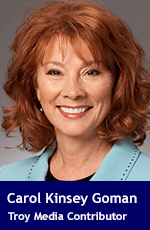 Lies in the workplace are expensive. According to the Association of Certified Fraud Examiners, a typical organization loses five percent of its revenue to fraud – a potential global loss of $3.5 trillion.
Lies in the workplace are expensive. According to the Association of Certified Fraud Examiners, a typical organization loses five percent of its revenue to fraud – a potential global loss of $3.5 trillion.
But the cost of out-and-out fraud pales in comparison to the monumental cost of the erosion of trust that occurs when workplace deception is condoned, tolerated or ignored. This loss of trust is expensive and damaging for any organization, but it is especially devastating for organizations trying to transition from hierarchy to collaboration.
Here’s why.
The key to making that cultural transition is knowledge sharing – and the foundation for knowledge sharing is trust.
Trust is the belief or confidence that one party has in the reliability and integrity of another; the confidence that one’s faith in the other will be honoured in return. Dishonesty destroys trust. Once you discover you’ve been lied to, trust simply vanishes – more often than not forever. And with it goes the very cornerstone of collaboration.
In The Truth About Lies in the Workplace, I offer an organizational strategy for reducing lies and increasing candour at work. It begins with you – the leader – asking yourself a series of questions. Here are four of them:
1) What do you expect of the people who report to you?
Pygmalion in the Classroom, one of the most controversial publications in the history of educational research, shows how a teacher’s expectations can motivate student achievement. This classic study gave prospective teachers a list of students who had been identified as “high achievers.” The teachers were told to expect remarkable results from these students, and at the end of the year, the students did indeed make sharp increases on their test scores.
 In reality, these children were not high achievers but had been chosen at random from the entire pool of pupils. It was the teachers’ belief in their potential that was responsible for their exceptional results; a belief that was communicated not directly (the students were never told they were high achievers), but subliminally through positive behaviours such as facial expressions, gestures, touch, and spatial relationships.
In reality, these children were not high achievers but had been chosen at random from the entire pool of pupils. It was the teachers’ belief in their potential that was responsible for their exceptional results; a belief that was communicated not directly (the students were never told they were high achievers), but subliminally through positive behaviours such as facial expressions, gestures, touch, and spatial relationships.
In much the same way, a leader’s expectations of employees’ potential can also play a key role in determining how well they perform at work.
So, again, the first question to ask yourself is: What do you expect of your team, staff, workforce? If you expect people to communicate with honesty, integrity and truthfulness – you’ve automatically increased the odds that they will do just that.
2) Have you covered the basics?
Charles A. Lynch has been chairman or chief executive officer of several major companies, including Saga Corporation and DHL. Talking with Charlie (which I always enjoy) is like taking a course in “Leadership 101”: Here’s what Charles has to say:
I’ve worked with a broad cross-section of companies – and I know that you are only as good as the people around you. At heart, I’m a fundamentalist. I believe that you need to have everyone focused on and in agreement with an overall mission and a three-year strategic plan. Then you have to make sure that each individual clearly understands his/her quantifiable one-year objectives – that those six to eight key objectives are clearly articulated, written down, and agreed to – and that there is no overlap in responsibility. After that, everyone can write their own performance review, because it is obvious when people did or did not reach the goals. And if they didn’t – we can discuss why not, and what needs to change. It all becomes transparent and upfront.
When you have an open communication platform in place, you lessen the chance of misunderstanding that causes people to cover-up, make excuses, and lie.
3) Are your words in alignment with your actions and body language?
Whenever your actions are in direct opposition to your statements, you confuse and demoralize your staff and look like a liar — as this email I received illustrates:
My boss drives us crazy with her mixed messages. She says things like, “You are always welcome in my office” and “You are all a valued part of the team.” At the same time, she is constantly showing how unimportant we are to her. She never makes eye contact, will shuffle papers when others talk, writes emails while we answer her questions and generally does not give her full attention. In fact, we don’t even get her half attention. Then she wonders why we’ve stopped believing anything she tells us.
If you want people to believe that you want and value their honest opinions, give them your full attention. Don’t multi-task while they talk. Avoid the temptation to check your text messages, check your watch, or check out your golf swing. (This actually happened. Whenever the boss lost interest in a conversation, he would stand, address an imaginary golf ball, and practice his swing.) Instead, focus on those who are speaking by turning your head, torso, and legs to face them directly and by looking them in the eyes.
4) Are you nice?
Linda Kaplan Thaler and Robin Koval were Chairman and CEO of Publicis Kaplan Thaler (now called simply Publicis), an ad agency in the United States. Small acts of niceness were reflective of their agency’s philosophy that “little things and niceness do make a difference.” A few of their tips create an atmosphere of trust in which people are more likely to tell the truth:
- Let people know it’s okay to have a “stupid” idea or ask a “dumb” question. In fact, it’s desirable.
- Let people know it’s okay to bring their whole selves (personal idiosyncrasies and issues) to work.
- Praise people for being open and honest, and minimize criticism for small missteps.
- Credit the entire team for a successful result.
- If you, as the leader, make an error, own up to it in front of the group.
- If it’s true, let people know that failure isn’t fatal – that they won’t lose their jobs if they make a well-intentioned mistake.
Leaders reduce deception and build (or reinforce) cultures of candour when they expect people to be honest, communicate openly and upfront, align their words with their actions, and treat people nicely.
Simple? Yes.
Easy? You tell me.
Carol Kinsey Goman, PhD, is an executive coach, consultant, and international keynote speaker at corporate, government, and association events. She is also the author of STAND OUT: How to Build Your Leadership Presence. For interview requests, click here.
The views, opinions and positions expressed by columnists and contributors are the authors’ alone. They do not inherently or expressly reflect the views, opinions and/or positions of our publication. © Troy Media
Troy Media is an editorial content provider to media outlets and its own hosted community news outlets across Canada.


